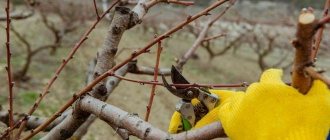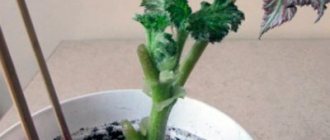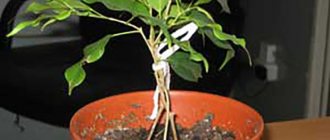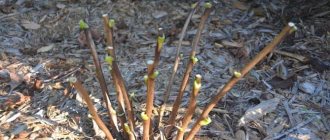Planting, transplanting, choosing a place for a Chinese rose
The first thing you should know is that the Chinese rose simply needs bright sunlight!
Place your beauty near the window so that the sun's rays easily penetrate the leaves of the plant. I’ll tell you a secret - the tree will not like the shadow, and it will refuse to delight you with exquisite flowers. In summer, you can even send the hibiscus outside; fresh air will promote flowering. You need to plant a Chinese rose in soil that you can easily prepare yourself. For it you will need:
- 2 liters of turf soil;
- 2 liters of leaf soil;
- 1 liter of humus (fine);
- 3 handfuls of coarse river sand.
By the way, when replanting an adult tree into a new container, try not to injure the root system, otherwise it will take a long time to take root. It is much easier to simply transfer the plant into a larger container and add pre-prepared substrate. I advise you to do the same with a large tree - remove the top part of the soil and add fresh soil.
How to replant
If you need to transplant Syrian hibiscus to a new place, do it in the spring before the plant begins to bloom. Move the bush along with the lump of earth. In the new location, trim the crown of the bush so that all the leaves have enough nutrients from the soil.
Syrian hibiscus requires regular feeding with phosphorus-potassium fertilizers. Phosphorus is necessary for the plant to bloom vigorously, and potassium increases its frost resistance. Potassium salts effectively repel garden aphids, and this pest is the most dangerous for shrubs.
In the northern regions of our country, gardeners grow outdoor hibiscus in tubs. This allows you to move the plant to a warm place for the winter, and in the spring, when the plant wakes up, return it to the street. If you plant three bushes with different types of flowering in one tub, you will get a beautiful composition when they all bloom at once.
Rules for successful pruning
- First you need to decide for what purpose the pruning is carried out and in what way it will be carried out. The formation of flowers in Chinese roses occurs at the tops of the stems. When the branches are pruned, the tree begins to bush more and produces more flowers. The plant is pruned in early spring; hibiscus can be trimmed a little in the fall.
- Pruning tools must be clean and very sharp. Poorly sharpened scissors and knives make the cut torn, worsen the appearance of the plant, and cut branches will take a long time to heal. Before each pruning procedure, tools are not only washed, but also disinfected. It is best to use alcohol for disinfection.
- It is best to prune hibiscus after transplantation, in spring or summer. After the procedures, caring for the rose remains the same.
- Even before you start pruning, you need to decide what shape you need. All cuts must be made at an angle of 45 degrees. Caring for a rose immediately after pruning, in order to avoid infection of the Chinese rose and for faster healing of wounds, includes sprinkling all cuts with crushed charcoal. You can use charcoal or activated carbon.
- The top of the plant is trimmed, moving away from the place where the last upper branches grow. The shoots are shortened a second time when the plant finishes flowering.
- The main rule for pruning a Chinese rose is that you can trim no more than 2/3 of all branches.
Thanks to these rules, the plant will receive minimal injuries, which will heal quickly.
How to prune hibiscus
The most popular form of hibiscus, which has a very impressive appearance, is the standard.
Forming it at home is not so easy, and after the plant takes on the desired shape, regular care is required for the branches to maintain the standard shape of the crown. But if you follow the instructions, you can get an amazing standard Chinese rose tree.
- To obtain a standard form, choose a young hibiscus. Its central shoot must be straight. Then this shoot is tied to a reliable support at the same distance and is not removed until the trunk becomes strong and stable. Growing side shoots are periodically removed.
- When the plant reaches the required height, the top of the plant is pinched. This is done to stimulate the growth of side shoots.
- After removing the top, the hibiscus will begin to actively branch. Therefore, the side branches are shortened and pinched monthly. This measure will promote the growth of dormant buds and the growth of new shoots.
- All lower shoots continue to be removed, but the upper ones are not touched. Over time, the plant will acquire the desired spherical shape.
To maintain a neat decorative shape at home, careful care is required. Hibiscus is periodically trimmed, preventing the crown from growing. The haircut is done once a year in the autumn months. If you do this at another time, the hibiscus will not bloom.
You can try growing a bonsai-style tree from hibiscus. But the formation of a Chinese rose for such a plant is very difficult and time-consuming. Professional florists can produce beautiful trees decorated with many flowers.
Such plants will look very impressive and unusual in the interior. The main problem when forming a bonsai is that the hibiscus branches quickly become thick and woody.
To form a bonsai, you need to take a young plant. Its branches are tied to supports and tension devices
You need to guide their growth very carefully; this can be done using wire
When a young plant begins to form, this may affect flowering, but for the sake of a beautiful, well-groomed form, it is worth waiting for the flowers to appear. In trees that are already formed in the bonsai style, the shoots are shortened after flowering ends.
Chinese roses withstand the procedure of pruning and shaping fairly well, so special care for them after the work is not needed. All fertilizing and watering are done as usual.
You should not be afraid to radically trim and thin out your hibiscus; on the contrary, by getting rid of old and unnecessary branches, the plant receives more nutrition for the formation of flowers and the growth of new strong shoots. Proper formation of the plant's crown will make the hibiscus the main decoration of your home or greenhouse.
Advice from experienced flower growers
Flower growers recommend a form for pruning in the form of a trunk. It is not easy to form.
Article on the topic: Mulberry tree: growing and care, photo, planting in the garden, pruning, grafting, types and varieties
Forming a rose bush with a trunk
Chinese rose: pruning and forming a bush into a standard - step-by-step instructions:
- To obtain a standard form, choose a young hibiscus. The shoot in the center should be upright.
- A support is placed nearby, to which the hibiscus is tied. It is left until the trunk becomes stronger.
- Side branches must be cut off.
- Remove the top after the flower reaches the height required by the grower.
- Trim the lower shoots until the hibiscus acquires a spherical shape (needs 2-3 months).
Then proper care is required to maintain its shape: periodically you need to pinch it so that the hibiscus looks like a bush.
In autumn, flower growers advise pruning: this will allow the Chinese rose to bloom.
The procedure for pruning a Chinese rose is quite simple; it cannot be neglected, since the plant needs it: if you do not prune the hibiscus, it will not only look untidy, but will also not be able to bloom profusely.
Chinese rose pruning procedure
Before carrying out the pruning procedure, you need to decide on the final result that you would like to obtain (size and shape). At the owner’s request, hibiscus can be used to make either a small tree or a spreading flowering shrub, which can easily be placed on the windowsill. To form a tree, lateral shoots from the second generation are removed. At the same time, several central shoots are left. The upper part is carefully shortened by several buds. This will form the future crown of your tree.
Crown formation
To form a bush, the central branch of the rose is cut off, which allows the lateral shoots to gradually develop into full-fledged stems. Several lower buds are left, and the central part is removed.
The plant tolerates the pruning procedure very well, so you can safely conduct experiments and implement your most interesting design ideas. There were cases when the above-ground part of the plant practically died, and the rose was reborn from underground buds.
After you have decorated the upper crown of the plant, the further process of pruning the Chinese rose will consist of the gradual removal of branches that grow parallel to the central trunk and deep into the crown of the plant. If they are not trimmed, it will interfere with the formation of a beautiful appearance. They also require additional nutrition and strength of the plant during its development.
Subsequently, when shoots of the third and subsequent generations appear, the Chinese rose is shortened by several buds. This procedure promotes the development of a larger number of young shoots, on which a significant number of new buds will form.
Trimming
It is important to prune Chinese roses correctly even after the end of the flowering period. Often this procedure is carried out in autumn or early spring - until the plant begins to actively develop
If you do this at the end of spring, then the hibiscus may not bloom at all in the summer.
The pruning procedure is carried out using scissors, since the plant’s branches are too thin for a special garden tool.
It is very useful when replanting in spring or replacing soil to cut all branches to a length of fifteen centimeters from the root. In this case, a few centimeters are left from the buds and leaves. The upper part also needs to be trimmed to the place where the last branches grow from the main trunk. When new shoots form, the weakest ones are simply removed.
If indoor hibiscus has never been pruned before, then such a radical procedure will only benefit it.
What will happen if the procedure is carried out?
Important! Some owners of this gorgeous plant, to put it mildly, “regret” cutting it off. In the end, of course, they only make things worse for him. Without the necessary surgery, the Chinese Rose will not be able to form beautifully, not to mention its size.
The bush will begin to grow as it wants - more in one direction, less in the other, and the leaves become less and less, without pruning the branches become bare. Shoots can also become deformed; if they are not shortened, then, accordingly, the appearance of the plant does not change for the better.
Flowering will be weak - there will be isolated flowers here and there, or even none at all. Pruning is required!
Fans of Chinese roses will find other articles about the plant useful:
- How to propagate a flower at home?
- Chinese rose Angel Wings.
- How to grow hibiscus from seeds at home?
- Plant diseases.
Aftercare
After completing all manipulations, the Chinese Rose can be sprayed with Epin for easier adaptation. And then we take care of it as usual, providing the conditions necessary for its successful growth and flowering.
- Watering - when active growth or flowering occurs, sufficiently abundant watering is needed so that the soil does not dry out, only the top layer dries out slightly. In cool times (autumn - winter), watering is not needed so often, but in any case the soil should not dry out, water about once a week. Only settled, soft water is suitable for irrigation.
- Humidity - you need to maintain air humidity at about 45 - 50%; for this you can place a fountain or just a vase with water next to the bush. It is also necessary to constantly spray the plant, only with soft and warm water, periodically rinse it in the shower, the leaves must be clean from dust.
- It is very good to use complex fertilizing, such as “Rainbow”, you need to apply it approximately once a month, and during flowering, 2 times a month.
- Temperature - in summer the desired temperature for the plant is 20 - 25 degrees, and in winter it should be maintained at approximately 18 - 16 degrees. Chinese Rose does not like drafts, the room needs to be ventilated, an influx of fresh air is mandatory for the flower, but the wind (especially cold) must be excluded.
- Lighting – you need good lighting, preferably on an eastern (or western) window; the light should be diffused, shaded from direct rays of the sun. In summer, it is very useful to take the flower out onto the balcony, into the fresh air.
Watch the video on the topic: “Caring for Chinese roses at home”
You can find out more about caring for Chinese roses here.
General rules for caring for Chinese roses at home
The Chinese rose is an easy-to-care plant. Below are the basic rules of care.
Illumination
Hibiscus can often be seen in dark hallways, where there is almost no light around the clock, as well as in other shaded areas. The plant grows in such conditions, but does not bloom flowers. Hibiscus needs sufficient light to bloom, so it is better to choose a place near a window. In summer, the rose should be removed from direct sunlight.
Temperature
The most suitable temperature for Chinese rose is from +20 to +25 degrees in the summer. Winter also does not frighten the plant with low temperatures. When the room is cool, hibiscus sets buds.
Note! The plant loves fresh air. If possible, it should be taken outside regularly. Drafts must be avoided.
Watering
The soil should not be allowed to become dry, as the leaves may fall off and flowering will stop. In hot weather, it is advisable to spray the plant once a day: spraying protects the hibiscus from pests. Settled water is used for irrigation.
Transfer
The Chinese rose grows quickly. You need to replant into a larger container every year. Spring is the best time. It is better to use loose soil as soil. There must be drainage. Before planting, you should trim off unnecessary branches. The best time to carry out this procedure is late February - early March.
Reproduction
The most common method of propagation is by cuttings. They are placed in a peat-sand mixture, covered with film for good rooting. Rooting can be done in water.
After rooting has taken place, you can plant the plant in containers with pre-prepared soil.
Features of care
To achieve success in growing a crop, it is necessary to water it in a timely manner, prune it, and apply fertilizer.
Watering mode
During active growth of the crop, it needs to be watered quite often. It is worth considering that the soil should not dry out. Drying of the top layer of soil by 3 centimeters is acceptable. The watering regime is selected taking into account temperature indicators. In summer, this should be done every other day. In autumn, the frequency of watering is reduced. In winter, 1 watering per week is sufficient.
Temperature and light
For normal development of culture, sufficient lighting is required. To ensure normal kidney formation, sunlight is needed. High-quality lighting will be the key to long and abundant flowering.
The optimal temperature for hibiscus is +26 degrees. In winter, it is recommended to reduce this indicator to +18 degrees. At low temperatures, buds form better. If the temperature is high in winter, you should not expect lush flowering.
Ambient humidity
The culture needs high air humidity. Therefore, it is recommended to spray the foliage with water in winter and summer. It is also permissible to use a container with wet pebbles. In this case, it is recommended to install the pot in such a way that its bottom does not come into contact with water. Sometimes a plant needs a warm shower. This procedure helps to saturate the foliage with moisture and cope with spider mites.
Spraying
In spring and summer, hibiscus should be sprayed at intervals of 2-3 days. In hot weather, it is recommended to perform this procedure every day. In this case, it is allowed to use only settled water.
Transfer
The Chinese rose is distinguished by its rapid growth. Therefore, it is recommended to replant young bushes annually. This is recommended to be done in spring or summer. Mature crops can be replanted every 4 years. At the same time, they should replace the top layer of soil with fresh one every year.
To replant the crop, it is recommended to place drainage at the bottom of the container. For this purpose, it is permissible to use expanded clay or small pebbles. The flower is planted in the center of the pot. Then you should carefully add soil and water the plant.
Fertilizer and feeding
Experts say that such plants are best fed with liquid fertilizers.
It is important to choose the right composition
Nitrogen
It is recommended to fertilize the rose with such means using a foliar method. To do this, take 1 gram of urea and mix it with 1 liter of water. After which it is recommended to spray the culture with a spray bottle.
Potash
It is recommended to use such products in the spring, when active development of the crop begins. Potassium is responsible for the formation of buds. To ensure normal root development, the plant requires phosphorus. Therefore, experienced gardeners recommend using potassium-phosphorus products.
Complex mineral fertilizers
In summer, it is advisable to use complex mineral preparations. It is worth considering that it is recommended to feed the bushes in the evening. Before carrying out the procedure, the rose should be watered.
Pruning and shaping the bush
Hibiscus pruning is carried out in the spring. This is done shortly before transplantation. In this case, there should be no flowers or buds on the bush. Pruning stimulates the flowering of the crop and the formation of a large number of flowering branches. At the same time, the bush itself becomes denser and more beautiful.
During the procedure, it is worth cutting off stretched, dry and bare branches. It is recommended to shorten the remaining shoots by half. The cut areas should be treated with garden varnish. At the same time, juice should not flow from them. Cut shoots will become good cuttings. You can get new bushes from them.
To rejuvenate an adult plant, all shoots are pruned at a height of 15 centimeters
It is important to ensure that at least 1 bud remains on each branch. As young shoots actively develop, it is recommended to get rid of weakened branches
In this case, strong and healthy shoots should remain. In summer, the bushes should be pruned again. In this case, the formation of flower buds on regrown shoots will occur only in September. But abundant flowering will last until spring.
Caring for a Chinese rose or how to achieve long-term flowering?
The plant loves a bright place, protected from direct sunlight. Hibiscus will not bloom in the shade. In the warm season, it feels great outdoors, so the bush can be placed on the balcony or in the garden. A place for this should be chosen that is protected from the scorching sun and drafts.
Air temperature and humidity
In summer, the hibiscus plant grows and blooms well at air temperatures from +18 to +25 degrees. In winter, the temperature should not be lower than +15 degrees, but home roses cannot tolerate heat either. At low temperatures, the plant may begin to shed its leaves.
Chinese rose loves high air humidity. Therefore, during hot periods and in winter, when the heating is on, hibiscus leaves must be sprayed regularly. Once a month, and if possible more often, it is recommended to bathe the bush under a warm shower. During this procedure, dust and possible pests (for example, spider mites) will be washed off the leaves, and the plant itself will be saturated with a sufficient amount of moisture. A pot of soil should be wrapped in cellophane before bathing.
Chinese rose - watering and fertilizing
Hibiscus love abundant watering, especially during flowering and active growth. But they should be watered only after the top layer of soil has dried. Constant waterlogging of the soil can lead to the development of fungal diseases and root rotting. Insufficient watering, especially in hot weather, domestic Chinese roses do not tolerate well and begin to shed leaves and buds.
The plant should be fed from March until the end of flowering. To do this, you can use the following complex fertilizers:
During the period of budding and flowering, the bushes should be fed every two weeks with fertilizers with an increased dose of potassium and phosphorus.
Fertilizers should be applied only after watering the soil, otherwise the roots of the plant may receive a chemical burn.
Hibiscus - replanting and pruning
Young plants are transplanted into larger diameter pots annually. Adult bushes should be replanted only after the root system becomes crowded in the old flowerpot. For replanting, you can buy special soil at a flower shop or prepare a mixture of the following components:
· peat soil – 1 part;
· humus – 0.5 parts;
· leaf soil – 1 part;
· turf soil – 1 part;
· sand – 0.5 parts.
Drainage (expanded clay, clay cuttings or broken brick) should be placed at the bottom of the pot.
Related article: Dill plant: planting and care in open ground, photo, how to grow at home
Many people do not know how to transplant a Chinese rose without damaging the roots. To do this, it is recommended to use the transshipment method. Having carefully taken out the bush from the old pot, it is transferred and placed in a new pot prepared in advance.
When and how to prune a Chinese rose
- one of the main questions for beginning flower growers. The purpose of pruning is to form a lush bush and increase the number of flowering shoots. Therefore, pruning is done before transplanting the plant in the spring:
1. Bare, elongated and dried shoots are removed.
2. Healthy branches are shortened by half.
3. To prevent juice from leaking from the wounds, the cut areas are treated with garden varnish.
4. When rejuvenating an adult bush, all branches are cut to 15 cm. In this case, at least one bud should remain on the shoot.
5. When new shoots begin to grow, weak ones must be removed.
6. In summer, the bush is pruned again. As a result, buds will appear on the old but renewed plant in the fall, and it will delight you with its flowering until spring.
Problems during cultivation
If you notice the symptoms of the disease in time, you can quickly determine the cause and correct the situation. Now we will describe what this or that symptom means.
Hibiscus sheds unopened buds.
- insufficient watering;
- low indoor air temperature;
- lack of nutrients.
The leaves are withering.
- insufficient watering;
- excessive watering, and, as a result, rotting of the root system.
The leaves dry out and curl.
insufficient air humidity.
Leaf fall.
- presence of pests;
- the flower stands in a draft.
The leaves turn yellow and dry out.
- watering is done with hard, most likely not settled, chlorinated water;
- low indoor air temperature.
The stems stretch, the leaves lose their bright color and turn pale.
lack of sunlight.
Indoor hibiscus does not bloom.
- pot too big;
- insufficient lighting;
- lack of fertilizers;
- no trimming has been done.
There are sticky droplets on the back of the leaves.
- insect pests;
- normal for some odorless varieties. This is how they attract insects for pollination.
The front side of the leaves has a white coating that turns brown over time.
Powdery mildew. Remove infected leaves. Treat the hibiscus with Bayleton or Fundazol.
Pinkish spots on leaves.
- excess fertilizer;
- lack of light.
Pests
Spider mite.
The leaves have yellowish spots and small cobwebs are visible. Spray the Chinese rose with insecticides, such as Fitoverm or Derris. Avoid excessive dry air; regularly spray the plant with water from a spray bottle. If spraying does not help, place the flower under an ultraviolet lamp.
Shield.
On the back of the leaves, hard brown growths are observed along the veins. Adult scale insects are not afraid of chemicals and will have to be removed manually. Then spray the plant with an insecticide solution. Repeat the procedure several times until you completely get rid of the scale insects.
Aphid.
Young leaves and shoots wither and curl. Small insects are visible on them. Spray the plant with aphid repellent according to the instructions.
Why is pruning needed?
Correct and timely pruning is vital for hibiscus, because with its help you can:
- Get rid of old and deformed branches. Over time, the branches of a plant can change shape. Some stretch out, others bend. So that they do not interfere with the growth of young shoots, they must be removed.
- Give the hibiscus the desired shape. Hibiscus cannot form a lush and beautiful crown on their own; new shoots grow, but look ugly.
- Rejuvenate the flower.
- Get rid of diseased shoots. Gardeners call this “sanitary pruning.” When cutting off diseased branches, it is necessary to capture healthy pieces as well.
- Accelerate flower growth and make flowering abundant.
Sometimes hibiscus roots are pruned. This procedure must be resorted to when the roots have grown too much and do not fit into the pot. © https://ydoo.info/qa/kak-obrezat-gibiskus.htmlPruning is carried out extremely carefully, as you must try not to catch the main roots.
Care after haircut
After the pruning procedure, the hibiscus needs to create optimal conditions.
Watering
Even in winter, watering roses cannot be stopped.
Hibiscus does not like too dry air. To make it moist, you can place a vessel with water in the room.
Rose leaves should be periodically washed in the shower to remove accumulated dust. During the period of active flower growth, the air temperature in the room should be at least 20 degrees, and in winter not lower than 16 degrees.
It is best to place a container with a flower in a room with windows facing west or east. If the room is heavily illuminated by the sun, then it is better to shade the flower from direct rays. In summer you can take the plant outside.
Top dressing
You can make fertilizers for Chinese roses yourself from available materials - shells or tea bags. But it is better to use proven methods and buy more nutritious products, such as mullein, mineral mixtures, and chicken droppings.
Organic substances include: wood ash, bone meal, compost, humus. To avoid burning the hibiscus roots, chicken manure and mullein must first be diluted with water. It is necessary to carry out such events at the dacha.
Infusions contain potassium and nitrogen. But for phosphorus nutrition it is better to use other substances (bone meal or wood ash).
If you immediately add soil and ash to the soil, they will neutralize each other’s effects and become useless.
Mineral fertilizer for hibiscus should include phosphorus and potassium. If the flower asks for more, which will be visible from the leaves (they will become sluggish), then you can spray it with a urea solution. If the flowers come to life, it means it needs nitrogen and should be sprayed again.
Shelter for the winter
- The bush is bent to the ground and covered with plastic film or other non-woven material.
- The rose is enclosed with a frame and insulated with material.
Tree varieties of roses cannot withstand severe frosts below eighteen degrees. Gardeners use the following methods on their plots:
- Cover with spruce branches or stems of other plants.
- A fence made of a wooden frame is installed and covered with non-woven insulation.
The spruce branches are placed near the bush in several layers. Snow will fall and reliably protect the plant from frost.
Covering hibiscus with other plants occurs in a vertical position. The material is tied in a bundle at the top and bottom. The result is a sheaf that will help save the rose from the cold.
The second method is to install a frame made of bars. The frame is covered with several layers of non-woven insulation. When spring comes and the frosts go away, the bush will need to be freed from insulation.
Hibiscus is an evergreen plant with colorful foliage. Even without flowers, it retains its decorative effect. If you follow all the rules for caring for it, you can enjoy luxurious flowering for several months in a row.
Garden hibiscus: cutting propagation
With the appearance of new shoots, old branches are removed. The soil around the plant is periodically loosened and weeds are removed. The peculiarity of the plant is that the blossoming flower lives for one day and then fades. For this reason, it is necessary to remove dry inflorescences in a timely manner.
During the period of active growth, the plant needs fertilizing with nitrogen and phosphorus fertilizers twice a month. In preparation for winter, potassium mixtures are added to the soil. If hibiscus does not bloom, it lacks boron and phosphorus. And shoot growth slows down due to lack of nitrogen.
Garden tree hibiscus develops better if it is trimmed regularly. Flower buds are formed on young shoots, therefore, the more young shoots, the more flowers are formed.
Pruning Syrian hibiscus
When to prune Syrian hibiscus? Pruning Syrian hibiscus is done in early spring, before shoots begin to grow. Pruning not only stimulates young shoots to grow, but also gives the tree hibiscus bush a decorative shape.
Growing hibiscus in the garden
Before covering the hibiscus with agrofibre, it is necessary to trim it. Each shoot is cut to 10 cm. All seed pods are removed. Pinch out the side branches so that the garden hibiscus forms new growth in the spring. The next year the growth will become woody and throw out flower buds.
Do not confuse pre-winter pruning with the formation of a hibiscus crown.
Indoor hibiscus
The hibiscus plant was well known back in Ancient Greece. However, at that time mallow was called this name. Hibiscus is known today as the Chinese rose. The plant is loved and revered on many islands that are located in the Pacific Ocean. For local women, hibiscus inflorescences are an exquisite hair decoration. Apparently, this tradition gave the name to the plant, since in translation “hibiscus” means “flower for beautiful ladies.”
Malaysians revere the hibiscus as their national flower; each petal of the inflorescence symbolizes an Islamic commandment. Residents of India and China treat this handsome man with respect. This plant is credited with miraculous properties - Easterners believe that hibiscus protects the home from evil intentions, helps business people succeed, and also gives strength to cope with depression.
Hibiscus pruning and grafting
necessary to prune hibiscus . This, on the one hand, contributes to the formation of a compact, beautiful crown, and on the other, promotes abundant flowering: after all, buds are actively forming on growing shoots.
Hibiscus easily tolerates pruning 3-4 times a year; thanks to this, it grows rapidly. Trimmed young shoots can be used for propagation by cuttings.
To get a hibiscus tree on which flowers of different varieties simultaneously , grafting is used into the green crown of the plant.
The best time for grafting is the end of spring and the beginning of summer, when active growth is underway and flowering is not very intense. A growing, slightly lignified shoot is selected from the hibiscus crown, partially cut off, leaving a “stump” 4 cm long.
How to organize planting and care of Hyacinth? What will you need for this? How to care for Gerberas in a pot - https://floradoma.com/komnatnyie-rasteniya/gerberyi-v-gorshke-kak-uhazhivat.html. Feeding and replanting an unusual plant.
They split it exactly in the middle to a depth of one and a half centimeters. Insert the lower end of the grafted cutting into the cut, “sharpened” on both sides with oblique cuts of the same length - 1.5 cm.
In this case, the tissues of both branches must be combined: bark - with bark, core - with core. The grafting site is wrapped - preferably with fluoroplastic tape - and the grafting is allowed to take root for 2 months. Then the tape is removed, and the grafting site is covered with garden varnish.
Reproduction of indoor hibiscus
Indoor hibiscus propagates both by seeds and cuttings. However, the seeds are too much trouble for a novice plant grower - this method is quite labor-intensive and is more suitable for those who are engaged in the selection of indoor hibiscus. And propagation by cuttings has several undeniable advantages. Firstly, this method preserves all varietal characteristics inherent in the mother plant
And secondly (which is especially important for an amateur plant grower), with this method the plant begins to bloom in the first year
Propagation by seeds
It is better to sow seeds from late January to mid-March. Before planting seeds in the ground, they should be soaked for 12 hours in Epin. The seeds need to be planted in a mixture of peat and sand. After planting, the pot is covered with glass or film to create greenhouse conditions. It is necessary to constantly maintain the temperature within 25-27 degrees. Also, do not forget to periodically ventilate the pot and spray the soil with the seeds.
When the young sprouts have 2-3 leaves, they can be transplanted into a separate pot. Hibiscus grown from seeds will bloom only in 2-3 years.
Propagation by cuttings
Young cuttings are best suited for propagation. To root, place them in water or soil. In the first case, you will need a vessel, preferably made of dark glass, filled with water. Place the cutting in it and cover it with a “cap” - for example, a glass jar. This is necessary to increase humidity. The cuttings will take root in about 25-30 days. When the roots appear, the cuttings will need to be transplanted into an earthen mixture containing a large amount of peat. It is advisable to add sphagnum moss there - this is especially useful for a young plant.
When rooting directly in the ground, you will need a mixture consisting of coarse sand and peat. But do not forget that before this you must remove all leaves from the cutting except the top two.
What to look for when buying hibiscus for the garden?
In order not to make a mistake when choosing hibiscus, be sure to evaluate the assortment of local nurseries and garden centers, contact experienced gardeners, and do not buy plants from catalogs (especially foreign ones): for the ability of hibiscus to survive winter, acclimatization and adaptation of mother plants is critically important.
Simply belonging to a hybrid will not give any guarantee. Therefore, choose trusted sellers with a good reputation. Since the different varieties of this plant suitable for growing in your area usually cover the entire palette, just choose the appropriate color and feel free to acquire a new soloist for garden compositions. When purchasing, check the growth form and the usual conditions for the plant.
It is better to purchase hibiscus for growing in open soil with an open root system, rather than in containers. The roots should be very powerful and well developed, thick and strong. At the same time, make sure that the seedlings have reached 2-3 years of age or older: the older the hibiscus is, the more frost resistance it will show.
Planting and propagating hibiscus
Growing hibiscus by seed is a troublesome and rather difficult task. If the planting material was purchased at a garden store, then germination rates are reduced to a minimum. Only those flower seeds that were obtained from “predecessors” can germinate best. In order to get healthy seedlings, you need:
- Prepare the soil, fill the planting container with a mixture of sand and peat.
- Sow the flower seeds in holes, the depth of which should be no more than 1 cm, after which the soil should be well moistened. The crop must be covered using a plastic bag or glass. Place the container with the flower in a warm place, making sure that the temperature there is at least +25 degrees.
- After the third true leaf appears, the seedlings need to be transplanted into separate pots.
When planting hibiscus by seed, its flowering begins after a year, in most cases - two years.
Hibiscus transplant
As for propagation by apical cuttings, this method is quick and simple. In order for hibiscus to take root successfully, it is recommended to use cuttings that were obtained during the process of pruning the plant. The length of the cut cuttings should be no more than 8 cm, and the sections that have been cut must be treated with a substance that promotes the formation of roots (Kornevin). To root apical cuttings at home, they need to be placed in a container with water or immediately planted in the ground. If you choose the latter method, you need to take a jar or other container and cover the pots with seedlings with it.
Important! After the first signs of growth appear, the cover will need to be removed. Often the roots develop within 30 days, and after 120 days the first buds can be observed blooming
How to replant hibiscus at home step by step
The first step before planting is to properly prepare the soil for hibiscus. In this situation, flower growers have two solutions: purchasing ready-made soil intended for growing Chinese roses or preparing the soil mixture on their own at home. To do this, you need to take clay turf - 2 parts, mix it with leaf humus, soil from the area near the garden, charcoal and vermiculite.
Mix these components thoroughly. Variegated hibiscus should be planted in containers that are 3 cm deeper than the previous ones. The transplantation process takes place with the onset of spring.
You need to carefully remove the hibiscus from the container; if there are dark old roots, be sure to remove them with sharp scissors or another sharp sterile object. Treat the areas where the roots were cut with charcoal.
Next, the root system of the flower is placed in a pot closer to the drainage layer. This will help protect the roots from increased soil moisture. The drainage layer, consisting of broken bricks or large pebbles, should occupy at least 1/3 of the volume of the pot.
Hibiscus care
Next, carefully install the plant, gradually removing or adding soil to achieve the desired position of the hibiscus in the new pot. Spread the soil evenly, filling all the remaining space. In this case, the root neck of the flower should remain at ground level.
Place the flower pot in a special tray and water generously with warm water. Wait for the excess water to drain, then remove the tray. If the soil has settled a little as a result of watering, it needs to be replenished.
Diseases and pests of hibiscus
- Spots on the leaves, a stunted, sickly appearance, shriveled stems: all this indicates that your pet is sick.
- Yellowing of the leaf on the underside is a normal process, but if yellowing occurs on a large scale, it means the plant has dried out.
- Excessive watering can cause the stems to dry out.
- If your plant grows on a garden plot, you take care of it according to all the rules of gardening, but it does not bloom, which means there is not enough phosphorus in the soil. The same can happen due to a lack of boron. Therefore, do not forget about fertilizers and feed your pet on time.
- Lack of sunlight makes the flower look sick and weak. In winter, after opening a window for ventilation, you need to put the pot in a warm place, otherwise it may freeze and die.
- When stickiness appears on the leaves, you should know that aphids are killing them. If the infection is mild, the leaves can be washed with soap and water, but if the infection is very serious, then it is necessary to use products such as: Biotlin, Iskra, Bison, Tobacco dust.
- If yellow specks appear on the leaves, which will later turn into discolored areas, this is a spider mite, which lives under the leaves in the web. Dry air and high temperatures contribute to the appearance of spider webs and mites. If the plant is not severely affected, then you can treat each leaf with a soap solution; in case of severe disease, you must resort to ready-made preparations. Infected hibiscus (aphids, spider mites) growing in a garden plot are best transplanted to another place, treated with the necessary preparations.
The plant is affected by non-infectious chlorosis caused by an excess or deficiency of potassium, magnesium, iron and nitrogen. To prevent it, regular feeding with iron chelate is carried out: iron sulfate (4 g), citric acid (2.5 g) are mixed in 1 liter of water.
We suggest you read: Prepare the spider web mushroom
Infectious chlorosis is accompanied by yellowing of leaves and the appearance of spots. The plant is periodically washed in the shower, the leaves are wiped, complex fertilizers are added to the soil and the plant is sprayed with them.
Vascular wilting is difficult to treat, but methods such as: trimming dried fragments, treatment with antifungal drugs (Grom, Zircon, Tsitovit), and spraying with Trichopolum solution (take 2 tablets per 1 liter of water) help in this matter.
Pest Control:
- When leaves are damaged by aphids, they are treated with Fitoferm, Tobacco dust, Intravir or soap solution.
- Scale insects are repelled with insecticidal preparations; Actellik helps well.
- The bush, if it is in the shade, is treated with mineral oil against scale insects.
- Whiteflies are killed with Karbofos, Tanrek, Bison and potassium soap.
- Spider mites are afraid of the following drugs: Akarin, Lightning, Vertimek.
- The buds affected by gall midges are cut off.
The soil is also treated with homemade products. Ground red pepper is poured with water (1:2), boiled for an hour, filtered. For 1 liter of soap solution, take 10 g of pepper broth and treat the ground. A decoction of mustard (50 g per liter of water) also helps well. It is kept on fire for 15 minutes, then the mixture is poured into 20 liters of water and the areas affected by pests are treated.
What harmful insects and illnesses should you be wary of?
The Chinese rose is an indoor flower that can be affected by spider mites, thrips or aphids. Insect infestations occur when care requirements are not followed. The problem often occurs when the air in the room is dry. Spraying the foliage of Chinese roses from a spray bottle will help prevent it. The water should be at room temperature and settled. You also need to pour small pebbles (gravel, crushed stone) into the pan and moisten them well with water.
Once every 2 weeks, the flower is sprayed with an infusion of hot pepper mixed with soap. This composition perfectly fights against uninvited guests on flowering shrubs.
If the culture is heavily infected, it is treated with Actellik solution once every 14 days, which is prepared by diluting 15 drops of the composition in a liter of water.
Some gardeners have to deal with yellowing leaves of Chinese roses. The problem is caused by a disease called chlorosis, which occurs due to an excess of chlorine and calcium in the water used for irrigation. Pre-settling the water before watering the flower will help prevent the development of chlorosis. Iron chelate is also added to the water in the dosage recommended by the instructions.
Possible errors and their prevention
It is worth paying attention to what mistakes you should not make when pruning the Chinese Rose:
- You should not perform this procedure during flowering, as this can greatly weaken the plant. If you urgently need to remove a diseased branch, then you will have to do it very carefully, without touching others, and be sure to treat the cut area afterwards.
- You cannot prune a flower in winter, when it is at rest, unnecessary processes may start.
- It is strictly forbidden to take poorly sharpened tools and make cuts with them - after all, you will end up with uneven, torn edges, which will not heal well, and the plant will immediately look sloppy.
Pruning a home flower
How can you prune a house flower? Depending on the age of the plant, its condition and the expected shape of the crown, there are 5 types of pruning:
- Pinching is suitable for young plants.
- This is the most gentle type of pruning.
- Used to stimulate growth.
- It consists of removing the tops of all branches above the top node.
- You need to pinch when the plant is about 13 - 15 cm high.
- To strengthen the trunk when pinching, the central shoot is attached to a base (for example, to a bamboo skewer).
- Selective pruning is done not only to stimulate growth, but also to maintain the shape of the plant. This type of pruning is a more thorough shortening of branches: several already well-developed internodes are cut off. Certain areas that disrupt the shape of the crown are trimmed.
The sequence of this type of hibiscus pruning is as follows:
- Trim the side shoots, leaving up to 4 - 5 leaves.
Make the cut just above the node, leaving at least 2/3 of the branch.
- Branches growing parallel to the central trunk and inside the crown also need to be pruned.
- Pruning should be done above the growing point, which faces outward.
Reference: the cut is made at an angle of 45 degrees. - Full pruning ensures abundant flowering of the plant. Produced in early spring to obtain abundant flowering. When fully pruned, each branch is shortened to two to three buds.
- Sanitary pruning involves removing disease-damaged areas of the plant. The cut is made until living wood appears. If the cut is green, then the branch is alive. A brown and white branch cut requires immediate pruning.
When pruning, do not try to leave as many shoots as possible. Don't be afraid to trim! Even if you cut off the excess, the plant will survive everything. Pruning tools must be sharp and disinfected.
When is pruning done?
The process of pruning hibiscus is carried out in the spring before the flowering stage and in the fall, but no later than September. The bush cannot be pruned between October and March. If it was transplanted in the summer, then after planting it can only be shortened.
in spring
The hibiscus flower forms on the top of the head. The more the flower bushes, the more abundantly it blooms. The circumcision site should be above the kidney at an angle of 45 degrees.
In the spring, the bush is completely pruned, all branches are shortened by 2/3. And it is also necessary to remove all the “tops” growing parallel to the main trunk.
in autumn
In the fall, it is necessary to prune all branches that have already faded. At this time, formative pruning is carried out, and diseased and broken branches are removed. In the fall, you can cut the hibiscus down to a stump and put it in a cool place in the shade, and in the spring it begins to actively grow.
Why is hibiscus pruned?
Pruning is vital for hibiscus for many reasons:
- Relieves the plant of deformed branches. As hibiscus grows, underdeveloped and twisted shoots appear. If you remove them in time, then full-fledged shoots will appear in this place.
- Gives the bush the desired shape. Indoor hibiscus, growing without proper care, will not be able to please you with a rich crown. The plant will devote all its energy to old and weak growth, flowering will become scarce, and over time it will disappear altogether.
- Rejuvenation. As a plant ages, it produces a lot of dead branches; pruning allows you to remove the excess and rejuvenate the plant, giving it a good boost.
- Removing diseased branches. Regular and timely sanitation will rid the plant of branches damaged by diseases and pests. This pruning will prevent the disease from spreading to healthy shoots.
- Root trimming. This event is carried out only in cases where the roots of the Chinese rose have grown greatly and it is crowded in the container. Root pruning promotes good growth and promotes lush flowering.
Why do they prune?
Pruning indoor hibiscus or “Chinese rose”, as it is popularly called, is vital. There are a number of reasons for this:
- To get rid of deformed shoots , over time some become bent, become short and take on an irregular shape. This needs to be corrected: cut off the crooked ones, in whose place new ones will grow.
- To give the plant shape. The plant is not always able to grow a lush “hair” on its own - instead, only old shoots grow back. That's when pruning is required. Just don’t forget that after this the flower spends all its energy on growing new shoots, so it either doesn’t bloom at all or blooms weakly.
- To rejuvenate the plant. Over time, the flower develops a lot of old dried twigs, which need to be disposed of urgently.
- To get rid of diseased shoots. In this case, it is called “sanitary” pruning: the affected parts of the plant are removed, including healthy parts.
- So that the plant grows well and pleases with abundant flowering. In some cases, the roots of a flower are pruned , but this happens extremely rarely - mainly when the root system has grown too much and there is not enough space for it in the pot. In this case, you must act very carefully - you can damage the roots.
How to replant hibiscus
The first transplant of indoor hibiscus should be done a couple of weeks after purchase. Stores use a depleted substrate to prevent the plant from growing too much while it sits on the counter. But if you bought a flowering specimen, wait until the end of flowering, otherwise all the flowers will fall off. Further, young specimens less than 3 years old are replanted once a year in early spring, slightly increasing the diameter of the pot. Older specimens are replanted once every 2-3 years, but adult large bushes are no longer replanted at all. It is enough to renew the top layer of soil.
Pot
Each time the new pot should be a little larger than the previous one. But you can’t immediately take too large a container, otherwise the plant will put all its energy into the growth of roots and foliage, leaving you without colorful flowering this year. The diameter of the pot should be increased until it reaches 30-40 cm. In the future, new pots are not used, and replanting can be done in the same pot. Otherwise, you will grow a rather large bush at home and will face the problem of placing it.
The soil
For indoor hibiscus, loose soil with neutral acidity is suitable. The easiest way is to buy ready-made soil for hibiscus in the store. If this is not found, you can prepare the mixture yourself:
- Buy universal soil for indoor plants and dilute it with an equal part of garden soil with the addition of moss.
- Mix the same universal soil with turf soil and humus in equal proportions. Add some charcoal.
- Mix 2 parts humus or rotted compost, 1 part leaf soil, 1 part sand or vermiculite.
Transplantation process
- Sterilize the pot and prepared soil.
- Place a thick layer of drainage and some soil at the bottom of the pot.
- Remove the hibiscus from the old pot along with the earthen lump. Shake off the earthen lump a little, but not completely.
- Carefully inspect the roots. If you find rotten roots, cut them off.
- Place the bush in the center of the new pot and pour soil between the earthen ball and the walls. Shake the pot a little during the process so that the soil is poured into hard-to-reach places and settles a little. Add some soil on top, compacting it slightly.
- Water and spray your hibiscus well.
- Return the bush to its old place. The plant does not like moving, and even more so after transplantation, it does not need unnecessary stress.
Correct formation of the hibiscus crown
There are two types of hibiscus crowns that can be formed: a lush or horizontal shape.
A lush crown is formed much more often than a horizontal one. The shape is chosen independently, whichever one likes best or suits the design of the room. The main advantage of hibiscus is that it can be grown as a lush bush or tall flowering tree.
Pruning is performed using ordinary scissors; the branches of the plant are thin, so the procedure will not be difficult. Cut off shoots located parallel to the main branches, as well as all dried elements.
To give the plant fullness, the area above the leaf facing outwards is cut off by 1/3. Pruning is carried out annually, in the spring. This procedure is also performed in the fall, after active flowering. In the absence of such a procedure, the plant will stop blooming, since flowers appear only on the shoots of a young species.
It is better not to prune in the summer, as the bush will not produce flowers.
Hibiscus in the house: signs and superstitions
How many contradictions are hidden in such a popular flower as the Chinese Rose or Hibiscus! The possible influence on a person may be different, but to a greater extent superstitions and signs are associated with people’s imagination and have nothing to do with the real state of affairs. Hibiscus is the flower of death, as many “knowledgeable” people claim, and if flowering occurs at the wrong time, then a misfortune will happen to someone close to you. No one knows where this belief came from, but many are afraid to keep a luxurious tree with spectacular buds at home, and grow the plant in offices and public places.
There is another opinion - Hibiscus carries powerful energy, invigorates creativity, activates the circulation of active matter around itself, because the flower belongs to the sign of Fire. A plant with a masculine principle restores the flame of love in spouses who have been married for many years. In many eastern countries, Hibiscus is considered a talisman for the hearth and a talisman for good luck.
Which version is closer? It is up to each person to decide, taking into account his beliefs and character. If you want to have a Chinese rose, but there are concerns about bad signs, you can place a flowerpot with Hibiscus at work: a well-groomed, beautiful tree with bright foliage and large flowers will certainly delight colleagues and visitors.
Indoor hibiscus is an evergreen plant with spectacular, bright green foliage and luxurious, large buds. Even without flowers, the tree remains decorative. If you follow the rules, you can enjoy the luxurious blooms of the Chinese rose for several months.
More useful recommendations for gardeners about the features of caring for Chinese roses can be found in the following video:
Is it necessary to somehow prepare a plant in the garden for the winter?
Basically, the name hibiscus is associated with Chinese rose , which is successfully grown by indoor plant lovers in houses and apartments. However, there are garden varieties that winter well under cover, and even those that do not need insulation at all during light frosts.
Herbaceous and hybrid hibiscus tolerate frost well. In the conditions of central Russia, they do not need to be covered, but pruning before cold weather is mandatory. More delicate varieties, especially terry ones, tolerate low temperatures less well, so protection from the cold is mandatory for them.
Important! The plant's frost resistance increases with age. If the seedling is very young and will winter for the first time, it is better to cover it, no matter what variety it belongs to. If the hibiscus is grown from cuttings that have taken root in water, it is better not to plant it outside at all during the first winter, but to leave it in a pot indoors.
Our experts have prepared materials on growing and caring for garden hibiscus. And also about such a flower as the Syrian hibiscus.











